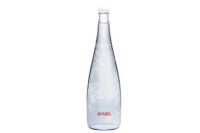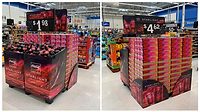Packaging design grabs attention
Style, clarity rate highly in packaging design

The packaging for Bomb Beer’s Bomb Lager embodies artistic expression and creativity as well as easy drinking, the company says. Every production of Bomb Lager will feature a new can design developed by a local street artist.







In the grocery aisle, the competition can be fiercer than a finale of “Project Runway,” the fashion design reality TV competition. Products are lined up next to their competitors with little to no opportunity to express why they should be the consumer’s choice. In food, drug, convenience and mass merchandise channels, one of the best ways to grab the consumer’s attention is with packaging design.
“In the shop, that’s where the real battle happens,” says Steve Kelsey, innovations director for PI Global, New York City. “You can do some very provocative stuff and very powerful stuff in advertising, but actually on the shelf [is] where the consumer makes up their mind, so from that perspective the [package] has to work incredibly hard.”
Following the trend
As competitive as the shelf can be for beverage-makers, developing a one-size-fits-all package can be easier said than done. Like the beverages themselves, packaging trends are subject to demographic population shifts, according to a Mintel report titled “Beverage Packaging Trends” released in January. The market research firm’s report finds that those who are older than 55 cite simple and easy-to-read beverage labels as being important. It adds that these consumers pay close attention to health claims, however, they do not believe this information is easier to find on a beverage label than on other packaging. The 55 and older consumer age group also is more likely to recycle than its other counterparts.
In contrast, Mintel found that those who are ages 25 or younger show a high acceptance for stylish, unusual designs, and are less likely to rate health and nutrition attributes as important. They also do not rate functional packaging and recyclable packages as important.
Last year, New York City-based craft brewer Bomb Beer released Bomb Lager, a new craft beer that embodies artistic expression and creativity, the company says. Every production of Bomb Lager will feature a new can design developed by a local street artist.
Mintel also noted the acceptance and action toward recycling by the Asian population. Although this demographic remains small, it is growing faster than any other race, with the Asian community in the United States estimated to grow more than 31 percent from 2006 to 2016, the report states. The demographic expressed a willingness to buy eco-friendly products if they were less expensive, but also a willingness to pay a premium for eco-friendly packaging. However, like the older consumer age group, Asians identified more challenges than the average consumer in finding and identifying calorie and sugar content of beverages when looking at the label, according to Mintel.
Easily identifiable
With a burgeoning natural and organic beverage market that offers products that contain fruit and vegetable juices, packaging design can be utilized to communicate to consumers about nutrients and value-added ingredients in a product, design firms note.
“We design with the strategy of a simplified communications hierarchy, so consumers understand what servings of fruits and vegetables they will be enjoying with each product purchase,” says Jackie DeLise, vice president of new business development for HMS Design. “Additionally, the visual metaphors represent the benefits of the product.”
She adds that when developing beverage packaging, the visualization of ingredients, for instance, communicates an appetizing appeal through photography or illustration that sets the standard for the brand from a flavor profile and taste attributes.
And with the proliferation of new product offerings within the beverage market, brand manufacturers are tasked even more to meet consumer’s evolving beverage needs, particularly in the premium refrigerated juice segment, she says.
“The category trend is toward a visual simplicity to allow the consumer the ease of shopping — and shop-ability in the category — to be confident in their brand selection based on the quality impression,” DeLise says.
Featuring a white background and highlighting images of its ingredients, Honest Tea, the Bethesda, Md.-based subsidiary of The Coca-Cola Co., initiated a packaging redesign last year. Tea leaves and large images of cut-open fruit are presented in an elegant and often playful way to reinforce the simplicity and deliciousness of its ingredients, the company says.
Consumers also echo the sentiments for simple and easy-to-read information on beverage labels. In Mintel’s “Beverage Packaging Trends” report, 79 percent of all respondents identified the most important feature of beverage labels as being easy to read without clutter. The report also finds that 72 percent of respondents want to easily identify whether a beverage is all natural, which can have an inherent audience.
“Women tend to have a greater interest in diet and nutritional claims in food and beverage products, so it’s expected that they over-index in being able to easily tell if a product is all natural and its nutritional content per serving and per container,” the report states.
But beyond a simplified, clean layout of information, design firms also are seeing an opportunity for package design to expand beyond the package through augmented reality or quick-response (QR) codes.
“The thing that’s really interesting is integrating these codes and symbols, which are not difficult to print, into beverage pack labels so we can have a very direct link between the pack design and what’s happening in the rest of media — the digital world that brands are creating for their consumers,” PI Global’s Kelsey says. “… It gives us the opportunity to do interesting things with games, promotions [and] all sorts of brand extensions.”
The increased extension of brands through packaging is a trend that market analysts see expanding in the future. Karine Dussimon, senior packaging analyst with Euromonitor International, Chicago, foresees the use of packaging as an initial platform that takes consumers to an online marketing campaign, a social network page or the brand owner’s website by using QR codes to better reach consumers, who are increasingly connected.
Environmental impact
Beyond communicating a brand message to consumers, packaging design also has a higher calling to deliver on environmentally friendly designs.
“Continued and increasing concern over packaging’s impact on the environment has encouraged a number of [fast-moving consumer goods] multinationals to further their development of more sustainable packaging solutions, such as lighter or even plant-based bottles,” Dussimon says. “In the case of lighter bottles — be it plastic or glass — it is often an investment in terms of research and development to solve the technical challenge that it represents, but it also often turns into a gain for all parties.”
The incidence of environmental concerns varies by region, she says. For instance, North America and western Europe are the most prominent, but in developing areas such as China it is becoming more important.
With major players PepsiCo and The Coca-Cola Co. developing sustainable plant-based packaging options, opportunities are expanding for the beverage market. In 2011, 5 billion of The Coca-Cola Co.’s PlantBottles were sold across 20 countries, up from 2.5 billion in nine countries in 2010, Dussimon says.
Highlighting sustainable packaging also was an important aspect of Johanna Foods’ launch of its Earth Wise line of juice and juice drinks in aseptic cartons. The package features the Forest Stewardship Council (FSC) logo, which verifies that the raw paperboard used to make the cartons was manufactured using only wood fibers that can be proven to originate from certified responsibly managed forests based on FSC guidelines. Other environmental benefits of the cartons include being lightweight, having a small carbon footprint, consuming very few resources and being fully recyclable, the company says.
Sizable opportunities
To reach a variety of households and consumers, manufacturers design multiple package size formats. In its “Beverage Packaging Trends” report, Mintel identified that multi-serving packages for beverages are the most popular at 94 percent purchase incidence with single-serving and multi-pack beverages recording 89 and 88 percent purchase incidence, respectively.
Touting the least expensive cost for each serving, multi-serve containers accommodate the need for large quantities of the household’s most consumed beverages, such as milk, juice, juice drinks and carbonated soft drinks, according to Mintel. However, the market research firm found that multi-serving and single-serving containers are purchased somewhat less frequently by consumers who are younger than 65 than by younger demographics. The multi-serve packaging, however, showed strong appeal to older consumers, likely because of its ability to accommodate smaller households, and because older consumers tend to be highly price-sensitive and prefer cost efficiency.
For multi-packs, aluminum cans are the most frequently purchased container, according to Mintel. Multi-packs also address the need for large quantities. For example, many juice product multi-packs contain 10 to 12 single-serve juices.
Last year, In Zone Brands announced its Value Packs, also known as “Plus 1 Packs.” Its BellyWashers Value Pack contains five 8-ounce bottles of BellyWashers 100 percent juice fruit punch and one free spill-proof character topper. The TummyTickler Value Pack contains seven 6-ounce bottles of TummyTickler 100 percent apple juice and one free spill-proof character topper for preschool-aged children. The TummyTickler Tots Value Pack contains 11 4-ounce bottles of TummyTickler Tots 40 percent reduced-sugar apple juice for toddlers and one free spill-proof character topper.
Also adding to its multi-pack offerings, St. Louis-based Anheuser-Busch, a wholly owned subsidiary of Anheuser-Busch InBev, introduced smaller-sized cans and bottles for its Select 55 brand. Now available at retailers nationwide, Select 55 “Little Lights” are available in 8-ounce 35-calorie cans in 12-packs and 7-ounce 32-calorie clear glass bottles in six-packs. The new smaller-sized cans and bottles also touch on another beverage packaging trend to clearly display calorie counts. The new size options were designed to appeal to those looking to limit calorie intake, the company says. BI
Looking for a reprint of this article?
From high-res PDFs to custom plaques, order your copy today!











